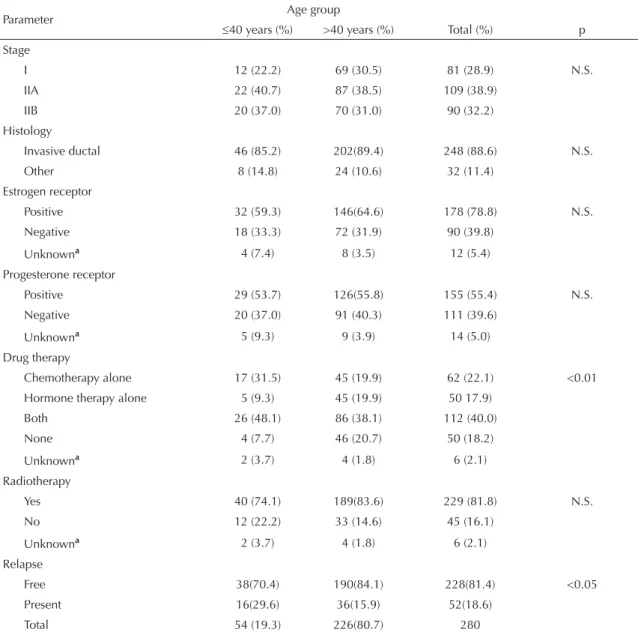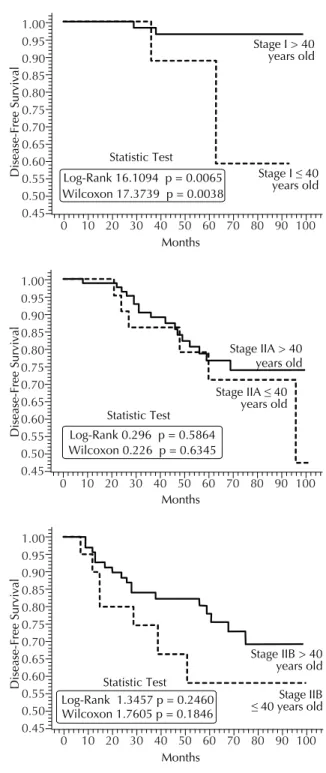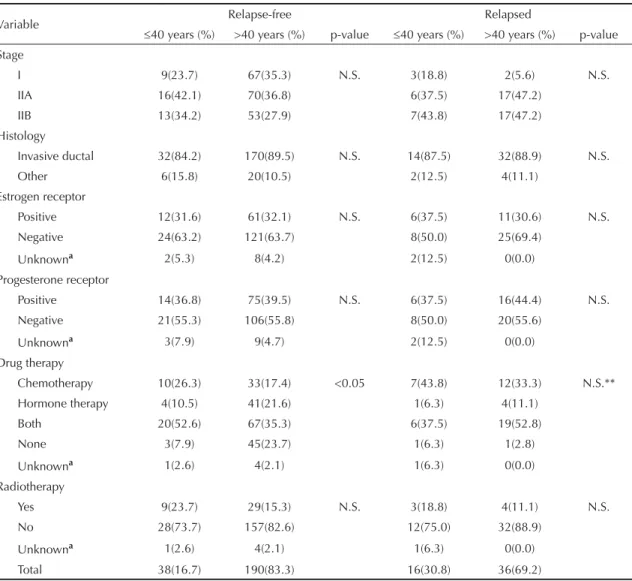Bernardo Garicochea Alessandra Morelle Ana Elisa Andrighetti Anna Cancella Ângelo Bós Gustavo Werutsky
Serviço de Oncologia Clínica. Hospital São Lucas. Pontifícia Universidade Católica do Rio Grande do Sul. Porto Alegre, RS, Brasil
Correspondence:
Bernardo Garicochea Hospital São Lucas da PUCRS Av. Ipiranga, 6690/708
90610-000 Porto Alegre, RS, Brasil E-mail: bgarico@terra.com.br Received: 1/2/2008 Revised: 7/31/2008 Approved: 9/5/2008
Age as a prognostic factor in
early breast cancer
ABSTRACT
OBJECTIVE: To analyze age as a prognostic factor in early breast cancer. METHODS: Retrospective study analyzing the clinical profi le and disease-free survival in a group of 280 subjects aged 25 to 81 years with stage I and II breast cancer followed-up in Porto Alegre, southern Brazil, from 1995 to 2000. Clinical, pathological, treatment and outcome data were obtained from medical records. Subjects were divided into two groups according to age at diagnosis (≤40 years and >40 years). The two groups were compared for clinical stage, histology, hormone receptor expression, therapy and radiotherapy using the chi-square and/or Fisher’s exact test and for analysis of survival the Kaplan-Meier method with a long-rank test.
RESULTS: Of 280 women studied, 54 (19.3%) were younger than 40 years. Both groups were similar regarding clinical stage, histology, and hormone receptor expression. The proportion of subjects with disease-free survival in the 56-month follow-up was signifi cantly higher in those over 40 years (84% versus 70%). Proportionally, younger subjects received more adjuvant therapy (88.8% vs. 77.8%). Those women over 40 years were signifi cantly more likely to remain disease-free (84%), and this difference was more remarkable when they were compared to those over 40 years at stage I breast cancer.
CONCLUSIONS: The study fi ndings confi rm that women younger than 40 years with early breast cancer have a poorer prognosis. However, this prognosis does not seem to be related to increased number of hormone receptor-negative cases. Younger patients who remained disease-free received more adjuvant therapy, suggesting a positive effect of chemotherapy and endocrine therapy.
DESCRIPTORS: Women. Breast Neoplasms. Age of Onset. Age Effect. Early Diagnosis. Prognosis. Retrospective Studies.
INTRODUCTION
Breast cancer in women under 40 years is uncommon and accounts for appro-ximately 7% of all cases at diagnosis.15 According to many epidemiological studies in the last 20 years,3,5,6,13 this group of patients has raised special interest for being associated with poorer prognosis when compared to cases diagnosed over the age of 40. The majority of these reports were done in Europe and United States. Cancer incidence, mortality and survival rates may vary according to different geographical areas.16 A recent population-based study in India reported higher survival rates for breast cancer in younger patients16 but clinical stages and clinical characteristics of the patients were not stratifi ed. Likewise, a report from Singapore4 found that patients with breast cancer under 35 years of age had a better prognosis than older ones.A Danish study13 demonstrated prognostic differences only in younger women with early stage disease.
need for a more aggressive approach if it is confi rmed that this population has high relapse rates and low survival. In developing countries, the characterization of young patients as high-risk group may promote the development of more specifi c and effective policies targeting this group of women. The objective of this study was to analyze age as a prognostic factor of early breast cancer.
METHODS
A retrospective and descriptive study was conducted based on secondary data to analyze patients with the diagnosis of early breast cancer who were treated in a university hospital in the city of Porto Alegre, Southern
Brazil, from 1995 to 2000. There were selected 280 cases of stage I and II breast cancer according to the American Joint Committee on Cancer criteria.7
Epidemiological, clinical, and pathology data about the tumor, treatment regimens, and outcomes such as tumor recurrence and survival in months were extracted from medical records. There were included patients with histology of primary tumor classifi ed as invasive ductal carcinoma, invasive lobular carcinoma, and other types. The extension of the intraductal component was not further categorized. The patients underwent mastectomy or breast-conserving surgery plus axillary lymph node dissection, adjuvant radiotherapy when indicated and were followed up after surgery in outpatient visits every
Table 1. Distribution of patients by clinical and pathologic characteristics. Porto Alegre, Southern Brazil, 1995-2000.
Parameter Age group
≤40 years (%) >40 years (%) Total (%) p
Stage
I 12 (22.2) 69 (30.5) 81 (28.9) N.S.
IIA 22 (40.7) 87 (38.5) 109 (38.9)
IIB 20 (37.0) 70 (31.0) 90 (32.2)
Histology
Invasive ductal 46 (85.2) 202(89.4) 248 (88.6) N.S.
Other 8 (14.8) 24 (10.6) 32 (11.4)
Estrogen receptor
Positive 32 (59.3) 146(64.6) 178 (78.8) N.S.
Negative 18 (33.3) 72 (31.9) 90 (39.8)
Unknowna 4 (7.4) 8 (3.5) 12 (5.4)
Progesterone receptor
Positive 29 (53.7) 126(55.8) 155 (55.4) N.S.
Negative 20 (37.0) 91 (40.3) 111 (39.6)
Unknowna 5 (9.3) 9 (3.9) 14 (5.0)
Drug therapy
Chemotherapy alone 17 (31.5) 45 (19.9) 62 (22.1) <0.01
Hormone therapy alone 5 (9.3) 45 (19.9) 50 17.9)
Both 26 (48.1) 86 (38.1) 112 (40.0)
None 4 (7.7) 46 (20.7) 50 (18.2)
Unknowna 2 (3.7) 4 (1.8) 6 (2.1)
Radiotherapy
Yes 40 (74.1) 189(83.6) 229 (81.8) N.S.
No 12 (22.2) 33 (14.6) 45 (16.1)
Unknowna 2 (3.7) 4 (1.8) 6 (2.1)
Relapse
Free 38(70.4) 190(84.1) 228(81.4) <0.05
Present 16(29.6) 36(15.9) 52(18.6)
Total 54 (19.3) 226(80.7) 280
a Excluded from chi-square analysis
three months in the fi rst two years and every six months from the third to the fi fth year. Subjects were divided into two age groups: one under 40 years of age and the other over the age of 40. The two groups were analyzed and compared regarding information about the tumor, treatment, clinical stage, histological type and grade, estrogen and progesterone receptor expression, previous chemotherapy, endocrine therapy and radiotherapy. The analysis of the human epidermal growth factor receptor 2 (HER-2) overexpression was not performed.
A comparison of clinical stage, histopathology and treatment between the two groups was carried out using the chi-square test or Fisher’s exact test when indicated. Disease-free survival was defi ned as the time in months since surgery up to local or distant recurrence, new breast cancer or death from any cause. Those who re-mained disease-free during follow-up were considered as not having signs of disease. Survival curves were constructed according to two groups of age and clinical stage using the Kaplan-Meier method. The long-rank test was applied to compare survival rates. Statistical analysis was performed using the EpiInfo software, version 3.3. A 5% level of signifi cance was set. The study was approved by the Research Ethics Com-mittee of Hospital São Lucas of Universidade Pontifícia Católica do Rio Grande do Sul.
RESULTS
A total of 280 subjects aged between 25 and 81 years and mean age of 51.8 years at diagnosis were studied. There were 54subjects aged under 40 years (19.3%) and 226 (80.7%) over 40. Table 1 displays the clinical characteristics of both age groups which were similar in clinical stage, histology and hormone receptor expres-sion. The two groups differed signifi cantly concerning
drug therapy after surgery; proportionally the younger group received more adjuvant therapy. Among those subjects who did not receive adjuvant drug therapy, endocrine therapy and chemotherapy 8% were younger patients and 20% were over 40 years.
During a median follow-up of 56 months, the pro-portion of patients who remained disease-free was
Figure 1. Probability curves for disease-free survival according to age groups. Porto Alegre, Southern Brazil, 1995-2000.
Disease-Free Survival
> 40 years old
≤ 40 years old
Months
84.1%
70.4%
Log-Rank 5.1471 p = 0.0233 Statistic Test
Wilcoxon 3.9785 p = 0.0461 1.00 0.95 0.90 0.85 0.80 0.75 0.70 0.65 0.60 0.55
0 10 20 30 40 50 60 70 80 90 100
Figure 2. Probability curves for disease-free survival accor-ding to age and clinical stage. Porto Alegre, Southern Brazil, 1995-2000.
Disease-Free Survival
Stage I > 40 years old
Stage I ≤ 40 years old
Months Log-Rank 16.1094 p = 0.0065
Statistic Test
Wilcoxon 17.3739 p = 0.0038 1.00 0.95 0.90 0.85 0.80 0.75 0.70 0.65 0.60 0.55 0.50 0.45
0 10 20 30 40 50 60 70 80 90 100
Disease-Free Survival
Stage IIA > 40 years old
Stage IIA ≤40 years old
Months Statistic Test Log-Rank 0.296 p = 0.5864 Wilcoxon 0.226 p = 0.6345 1.00 0.95 0.90 0.85 0.80 0.75 0.70 0.65 0.60 0.55 0.50 0.45
0 10 20 30 40 50 60 70 80 90 100
Disease-Free Survival
Log-Rank 1.3457 p = 0.2460 Statistic Test
Wilcoxon 1.7605 p = 0.1846
Stage IIB > 40 years old
Stage IIB ≤ 40 years old
Months 1.00 0.95 0.90 0.85 0.80 0.75 0.70 0.65 0.60 0.55 0.50 0.45
signifi cantly higher in patients over 40 years (84%) when compared to younger (70%) ones. A total of 52 (18.6%) patients had disease relapse, 15 (28.8%) local, 30 (57.6%) systemic, and 4 (7.7%) in both lo-cal and systemic. Due to the small number of deaths (28; 10%) seen during this period only relapse events were analyzed. Table 2 shows the clinical distribution of the two age groups in those patients who remai-ned disease-free and in those with relapsed disease. Among disease-free and relapse patients there was no relationship between age and clinical stage, histology, hormone receptor expression and radiotherapy. Drug therapy (e.g. chemotherapy and/or endocrine therapy) was signifi cantly associated with disease-free survival in younger patients. The distribution of drug therapy in relapsed patients presented a not valid chi-square test due to the small number of patients who received any of these therapies in both age groups.
Probability curves for disease-free survival for each age group are shown in Figure 1. The curve obtained for older women pointed towards a signifi cantly higher probability of being disease-free at any given time. Signifi cant differences in the probability of remaining relapse-free were also seen according to disease stage at diagnosis as shown in Figure 2. At stages IIA and IIB, older patients were more likely to be relapse-free than younger ones. Only stage I showed signifi cant differences in terms of disease-free survival between the two age groups studied.
DISCUSSION
In the present study, women under 40 years with early breast cancer had a poorer prognosis. The difference was specially seen at stage I in which disease-free survival was signifi cantly lower in the younger group, despite the
Table 2. Distribution of relapse-free and relapsed patients by clinical and pathological characteristics. Porto Alegre, Southern Brazil, 1995-2000.
Variable Relapse-free Relapsed
≤40 years (%) >40 years (%) p-value ≤40 years (%) >40 years (%) p-value Stage
I 9(23.7) 67(35.3) N.S. 3(18.8) 2(5.6) N.S.
IIA 16(42.1) 70(36.8) 6(37.5) 17(47.2)
IIB 13(34.2) 53(27.9) 7(43.8) 17(47.2)
Histology
Invasive ductal 32(84.2) 170(89.5) N.S. 14(87.5) 32(88.9) N.S.
Other 6(15.8) 20(10.5) 2(12.5) 4(11.1)
Estrogen receptor
Positive 12(31.6) 61(32.1) N.S. 6(37.5) 11(30.6) N.S.
Negative 24(63.2) 121(63.7) 8(50.0) 25(69.4)
Unknowna 2(5.3) 8(4.2) 2(12.5) 0(0.0)
Progesterone receptor
Positive 14(36.8) 75(39.5) N.S. 6(37.5) 16(44.4) N.S.
Negative 21(55.3) 106(55.8) 8(50.0) 20(55.6)
Unknowna 3(7.9) 9(4.7) 2(12.5) 0(0.0)
Drug therapy
Chemotherapy 10(26.3) 33(17.4) <0.05 7(43.8) 12(33.3) N.S.**
Hormone therapy 4(10.5) 41(21.6) 1(6.3) 4(11.1)
Both 20(52.6) 67(35.3) 6(37.5) 19(52.8)
None 3(7.9) 45(23.7) 1(6.3) 1(2.8)
Unknowna 1(2.6) 4(2.1) 1(6.3) 0(0.0)
Radiotherapy
Yes 9(23.7) 29(15.3) N.S. 3(18.8) 4(11.1) N.S.
No 28(73.7) 157(82.6) 12(75.0) 32(88.9)
Unknowna 1(2.6) 4(2.1) 1(6.3) 0(0.0)
Total 38(16.7) 190(83.3) 16(30.8) 36(69.2)
a Excluded from Chi-square analysis. ** Chi-square test is not valid
small number of events. In stage II patients, there was also seen a trend for poorer disease-free curves.
It remains unclear why younger women with breast cancer have a poorer prognosis. In previous studies,12,14 younger women commonly had tumors with certain poor prognostic features such as higher degree of anaplasia, negative estrogen receptor status, HER-2 overexpression, and high rate of affected lymph nodes. Some studies2 have suggested that the poor prognosis could be also attributed to a delay in diagnosis in this group of patients. Early detection of tumors in patients under 40 years who had been submitted to screening mammography can be diffi cult due to the higher density of mammary glands.11 The differences regarding lower survival and higher risk of recurrence seems to be more important in low-risk patients.
Studies performed in the late 1980s by the University of Pennsylvania and Fox Chase Cancer Center10 re-ported that younger women undergoing conservative surgery and radiotherapy for stages I and II breast cancer relapsed earlier than older patients. Despite the short follow-up of the study there were no signifi cant differences in relapse-free and overall survival. A longer follow-up study6 revealed that, compared with older patients, younger ones had a poorer prognosis in cases of negative lymph nodes and there was seen a trend towards statistical difference among those with positive lymph nodes. In a retrospective analisys9 of 252 Brazilian patients, age was not a prognostic factor for survival, regardless of the clinical stage. In the present study, the poorer prognosis seen in younger patients was not correlated with their hormone receptor status, a variable which has been clearly associated with high risk for breast cancer recurrence regardless of age and clinical features. At least one study1 reported that even estrogen receptor-positive young patients have a poorer prognosis than older ones. This raises a concern whether young patients with breast cancer are receiving
suboptimal treatment. A retrospective cohort8 from Denmark reported that the negative effect of young age on prognosis was almost exclusively seen in women classifi ed as having low-risk disease and who did not receive cytotoxic adjuvant treatment. In our study, younger women who remained relapse-free received more adjuvant therapy than the older ones. The odds that younger patients may have a poorer prognosis makes adjuvant therapy a treatment option to be con-sidered in most cases and therefore the administration of chemotherapy for younger patients may result in lower recurrence rates.
The fact that younger patients were identifi ed in pre-vious studies as endocrine-unresponsive evidences that breast cancer in women under 40 may follow a distinct carcinogenetic pathway.5,10 Since hereditary syndromes occur frequently in young patients it is plausible that many of these patients could have inherited BRCA1 and BRCA2 gene mutations. The high frequency of hormone receptor-negative cancers seen in BRCA1 and BRCA2 mutation carriers might be evidence that the de-fi cient cellular repair mechanism by BRCA-dependent pathway can be crucial in young breast cancer women. Family history was not assessed in the present study since it is very diffi cult to ascertain it in urban areas in countries such as Brazil, where migration of rural population is very common and data on the patients’ ancestors medical history cannot be reliably obtained.
1. Aebi S, Gelber S, Castiglione-Gertsch M, Gelber RD, Collins J, Thürlimann B, et al. Is chemotherapy alone adequate therapy for young women with oestrogen-receptor positive breast cancer? Lancet. 2000;355(9218):1869-74. DOI: 10.1016/S0140-6736(00)02292-3
2. Anderson BO, Senie RT, Vetto JT, Wong GY, McCormick B, Borgen PI. Improved survival in young women with breast cancer. Ann Surg Oncol. 1995;2(5):407-15. DOI: 10.1007/BF02306373
3. Chan A, Pintilie M, Vallis K, Girourd C, Goss P. Breast cancer in women ≤ 35 years: review of 1002 cases from a single institution. Ann Oncol. 2000;11(10):1255-62. DOI: 10.1023/ A:1008391401404
4. Chia KS, Du WB, Sankaranarayanan R, Sankila R, Wang H, Lee J, et al. Do younger female breast cancer patients have a poorer prognosis? Results from a population-based survival analysis. Int J Cancer. 2004;108(5):761-5. DOI: 10.1002/ijc.11632
5. Colleoni M, Rotmensz N, Robertson C, Orlando L, Viale G, Renne G, et al. Very young women (<35 years) with operable breast cancer: features of disease at presentation. Ann Oncol. 2002;13(2):273-9. DOI: 10.1093/annonc/mdf039
6. Fowble BL, Schultz DJ, Overmoyer B, Solin LJ, Fox K, Jardines L, et al. The infl uence of young age on outcome in early stage breast cancer. Int J Radiat Oncol Biol Phys. 1994;30(1):23-33.
7. Greene FL, Page DL, Balch CM, Fleming ID, Morrow M.American Joint Committee on Cancer. AJCC Cancer Staging Manual. Sixth Edition. New York: Springer 2002.
8. Kroman N, Jensen M, Wohlfahrt J, Mouridsen HT, Andersen PK, Melbye M. Factors infl uencing the effect
of age on prognosis in breast cancer: population based study. BMJ. 2000;320(7233):474-8. DOI: 10.1136/ bmj.320.7233.474
9. Morais AB, Zanini RR, Turchiello MS, Riboldi J, Medeiros RL. Estudo da sobrevida de pacientes com câncer de mama atendidas no hospital da Universidade Federal de Santa Maria, Rio Grande do Sul, Brasil. Cad Saude Publica. 2006;22(10):2219-28.
10. Nixon AJ, Neuberg D, Hayes DF, Gelman R, Connolly JL, Schnitt S, et al. Relationship of patient age to pathologic features of the tumor and prognosis for patients with stage I or II breast cancer. J Clin Oncol. 1994;12(5):888-94.
11. Petrek JA. Breast cancer and pregnancy. J Natl Cancer Inst Monogr. 1994;16:113-21.
12. Soerjomataram I, Louwman MW, Ribot JG, Roukema JA, Coebergh JW. An overview of prognostic factors for long-term survivors of breast cancer. Breast Cancer Res Treat. 2008;107(3):309-30. DOI: 10.1007/s10549-007-9556-1
13. Sundquist M, Thorstenson S, Brudin L, Wingren S, Nordenskjöld B. Incidence and prognosis in early onset breast cancer. Breast. 2002;11(1):30-5. DOI: 10.1054/brst.2001.0358
14. Walker RA, Lees E, Webb MB, Dearing SJ. Breast carcinomas occurring in young women (<35 years) are different. Br J Cancer. 1996;74(11):1796-800.
15. Winchester DP. Breast cancer in young women. Surg Clin North Am. 1996;76(2):279-87. DOI: 10.1016/ S0039-6109(05)70439-4
16. Yeole BB, Kumar AV, Kurkure A, Sunny L. Population-based survival from cancers of breast, cervix and ovary in women in Mumbai, India. Asian Pac J Cancer Prev. 2004;5(3):308-15.


